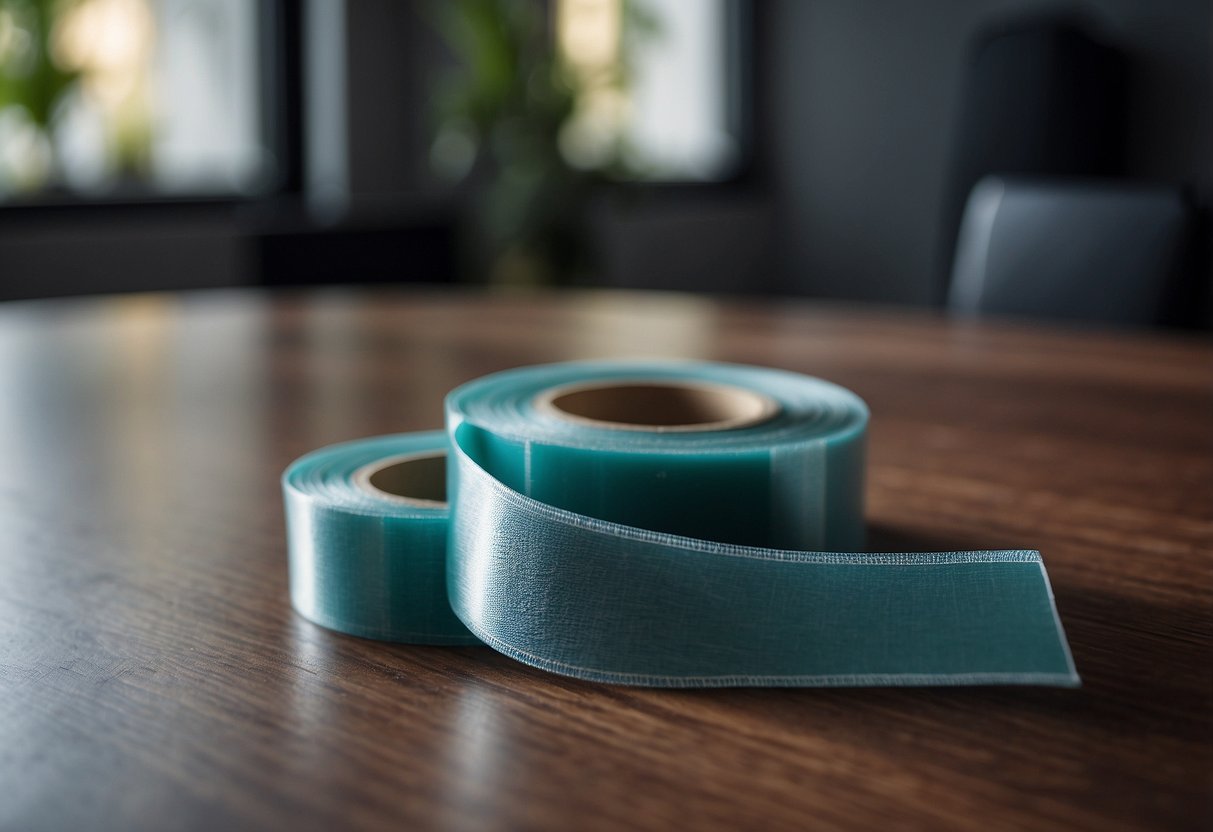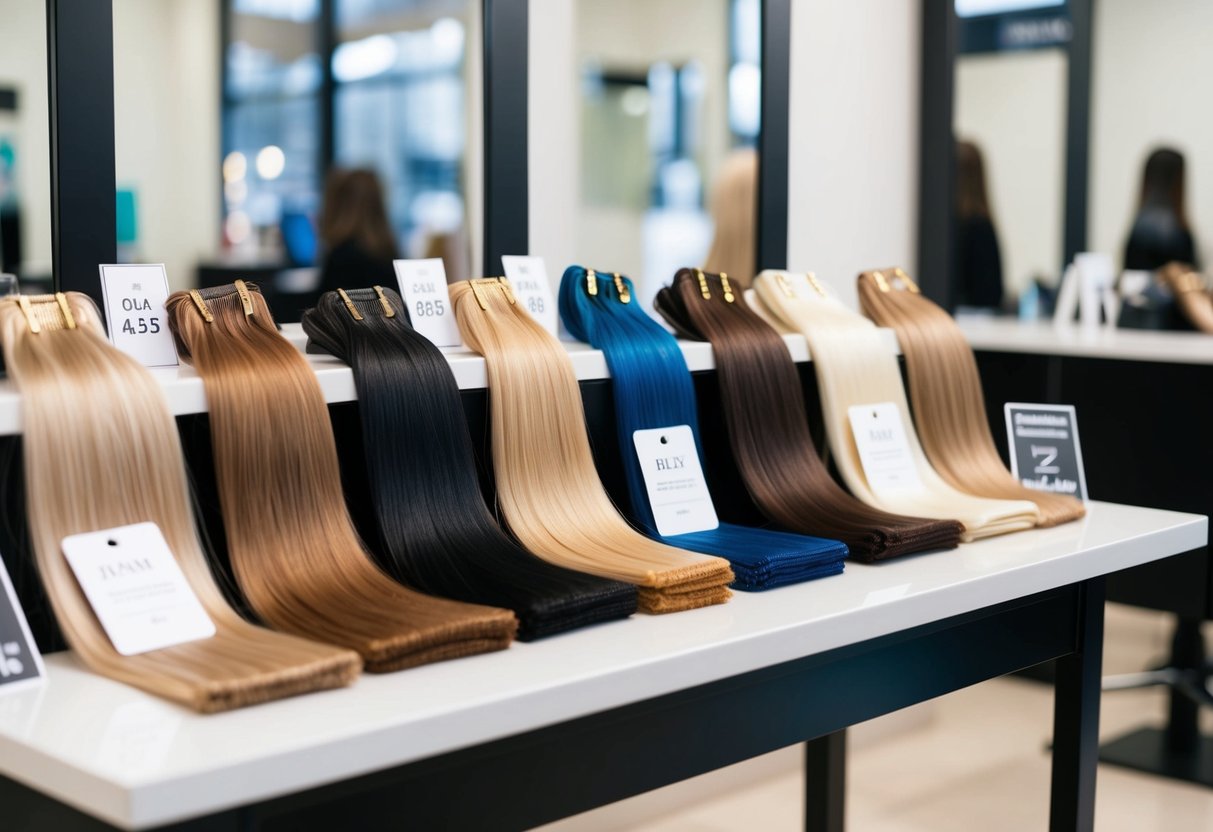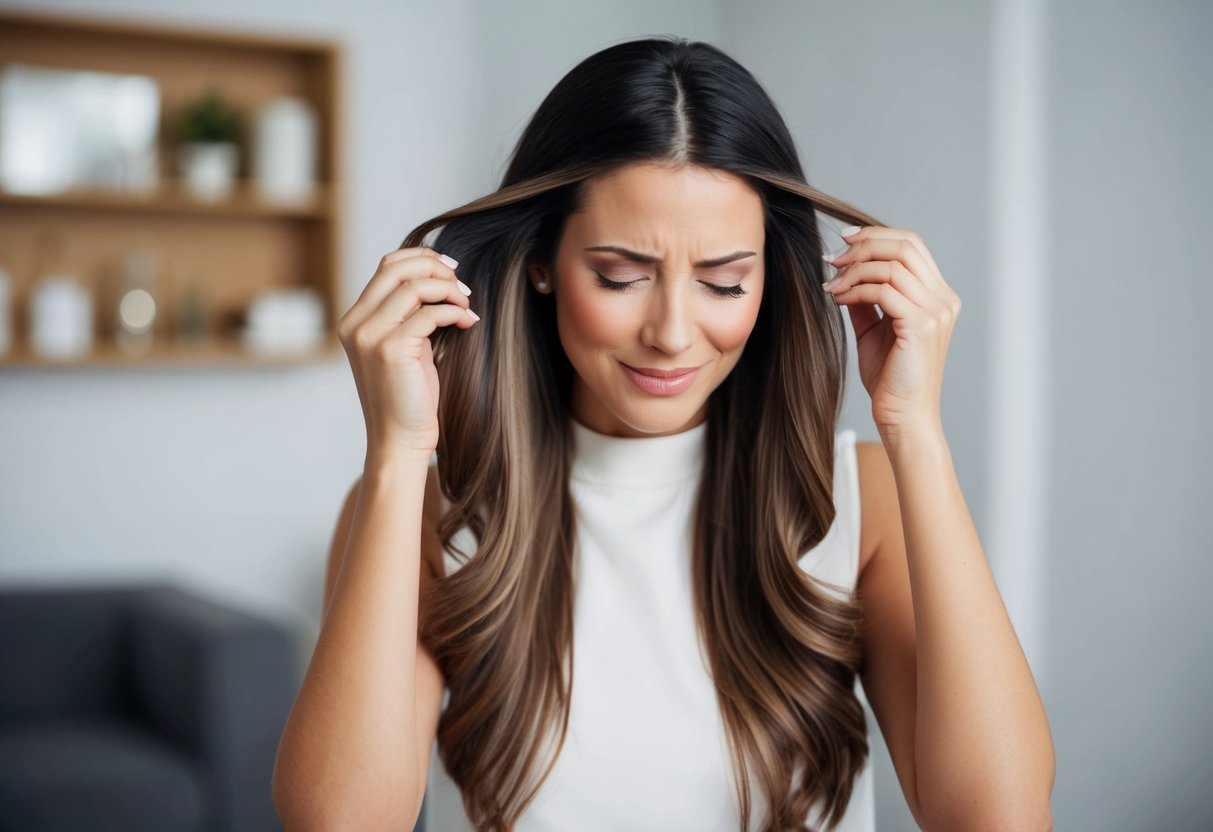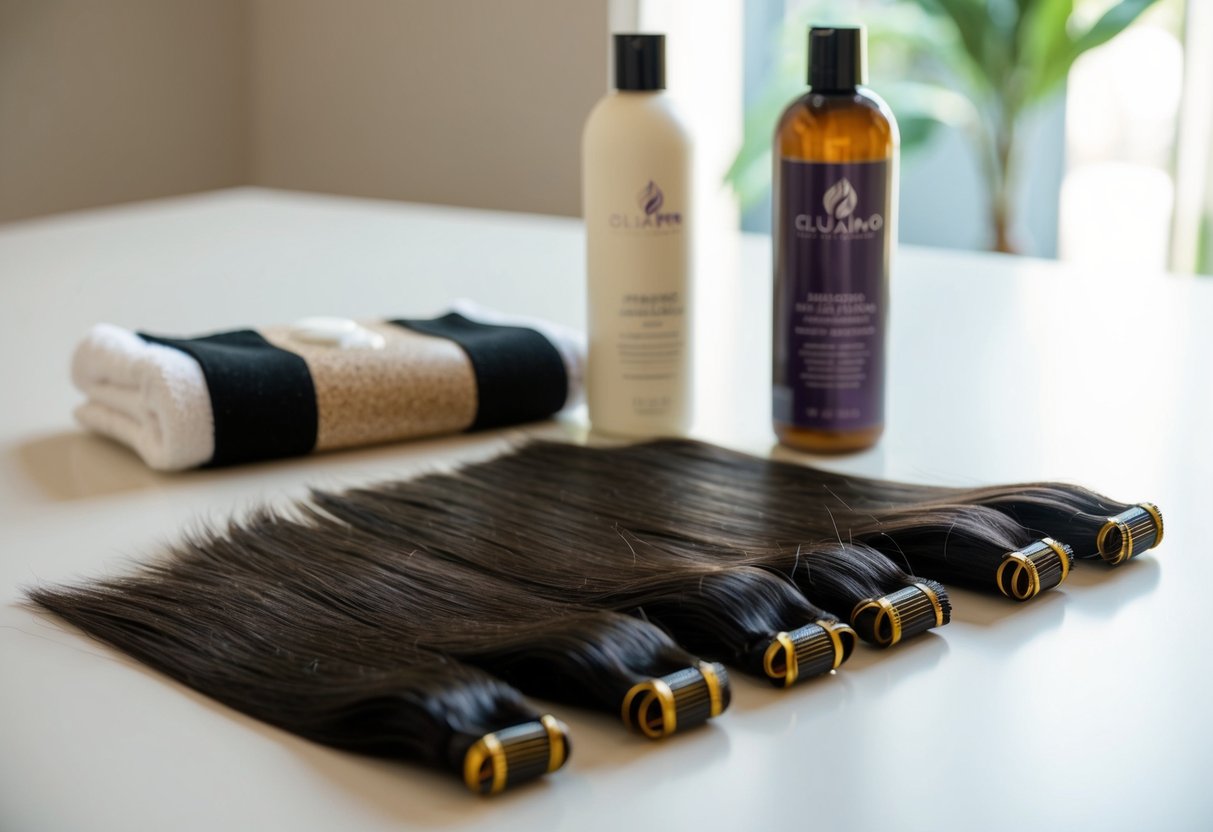Why Are My Tape In Extensions Not Sticking: Causes and Solutions

Proper application techniques are equally important. Pressing and holding the tape firmly for at least 10 seconds helps in securing the bond. Lastly, spacing the tape correctly, not too close to the scalp, can prevent unnecessary tension and ensure better adhesion.
Key Takeaways
- Hair must be free of oils and moisture for the tape to stick effectively.
- High-quality tape and firm application are essential for a strong bond.
- Proper spacing of the tape helps prevent tension and ensures better hold.
Understanding Tape-In Extensions
Tape-in extensions are popular due to their natural look and ease of use. To ensure they work well, it is vital to understand their components and the advantages they offer.
Components of Tape-In Extensions
Tape-in extensions consist of small sections of hair attached to thin, adhesive-coated strips, often called tapes.
The adhesive is specially designed to be strong enough to hold the extensions in place but gentle enough to avoid damaging natural hair. High-quality tape is essential; it ensures a strong and reliable bond.
Regular maintenance and proper application are necessary to keep these extensions secure and looking natural. Be sure that neither water nor oil gets on the adhesive, as this can weaken the bond.
Advantages of Tape-In Hair Extensions
Tape-in hair extensions offer several benefits that make them a favorite choice. They provide a natural appearance by blending seamlessly with your own hair.
They are quicker to apply compared to other types of extensions, often taking less than an hour. Additionally, they are less damaging since they do not involve harsh chemicals or tools.
These extensions are also lightweight, making them comfortable to wear. They can last for several weeks with proper care, offering flexibility and convenience.
In summary, the advantages of tape-in extensions include their natural look, quick application, minimal damage, and comfort.
Proper Application Techniques
The success of your tape-in extensions relies heavily on methodical preparation and precise application. Ensuring a clean scalp, accurate sectioning, and careful attachment can prevent slippage and extend the lifespan of your extensions.
Preparing the Scalp and Hair
Cleanliness is essential. Wash your hair with a sulfate-free shampoo to remove any oils or residue. Dry your hair entirely before application. Avoid using conditioners or oils near the roots, as they can interfere with the adhesive. Brushing your hair thoroughly helps remove any remaining tangles.
It's crucial that your scalp is in optimal health. Scalp issues such as dryness, oiliness, or dandruff can affect the tape's ability to adhere. Regular scalp maintenance, like routine exfoliation and moisturizing, can improve the application process.
Sectioning and Placement Strategy
Careful sectioning ensures that the tape tabs blend seamlessly with your natural hair. Divide your hair into small, neat sections using a rat tail comb. Leave at least an inch of space from the hairline to avoid visible tape when the hair is pulled back.
When sectioning, avoid overly thick or thin sections. The hair should be thin enough for the tape to adhere securely but thick enough to support the weight of the extensions. This balance is vital for both the result and the health of your natural hair.
Attaching the Tape Tabs
Place the first tape tab under a section of hair, close to the scalp but not touching it directly. Press the hair into the tape, ensuring that the strands are evenly distributed across the adhesive surface. Then, apply the second tape tab on top, sandwiching the natural hair between the two.
Use a pressing tool or your fingers to squeeze the tape tabs together firmly. This creates a secure bond. Avoid touching the adhesive with your fingers, as oils from your skin can reduce the tape's effectiveness.
Regularly check for loose strands that might not be secured within the tape tabs. This can prevent later slippage and ensure a smooth, natural finish. Proper attachment is key to long-lasting extensions.
Potential Causes for Non-Adherence
Several factors can prevent tape-in extensions from sticking effectively. Understanding the main issues can help in addressing and preventing these problems to ensure a secure fit for your extensions.
Presence of Oils or Products
Oils, whether natural or from hair products, can significantly affect the adhesion of your tape-in extensions. Oils create a slippery surface that prevents the adhesive from sticking properly. Even trace amounts of oil on your hair or the extension wefts can lead to a poor bond.
Hair products such as conditioners, serums, and sprays can also leave residues that interfere with the tape’s grip. It’s essential to ensure that your hair is thoroughly cleaned before applying extensions. Using a clarifying shampoo can help remove any build-up.
Additionally, consider avoiding oil-based products near the roots where the tape will be applied. This precaution can greatly enhance the chances of the tape sticking securely to your hair.
Inappropriate Tension on Extensions
The tension applied when securing tape-in extensions plays a crucial role in their adherence. If the extensions are placed under too much tension, the constant pull can cause them to loosen or unstick.
It's critical to ensure that the extensions are applied with just the right amount of tension. They should be snug but not overly tight. Overly tight extensions not only risk adhesion issues but can also cause discomfort and potential hair damage.
When you apply the extensions, make sure to press and hold the tape firmly for at least 10 seconds. This step helps seal the adhesive and ensures a strong bond, minimizing the risk of the extensions slipping or coming unstuck. Proper application methods can prevent many common problems associated with tape-in extensions.
Maintenance and Aftercare
To ensure your tape-in extensions stay secure and look natural, it's important to follow a proper maintenance and aftercare routine. Regular cleaning, managing natural oil production, and using specific tips can help prolong the stickiness of your tape-ins.
Regular Cleaning and Shampooing Routine
Clean your hair extensions at least once a week with a sulfate-free shampoo. Sulfates can weaken the adhesive bond, making the tapes less sticky. When washing, focus on the scalp and roots, but avoid scrubbing the tape area directly.
Rinse thoroughly to remove all shampoo and product buildup. Any remaining residue can cause the tape to slip. After washing, use a lightweight conditioner only on the mid-lengths and ends to avoid the tape area.
Managing Natural Oil Production
Natural oils from your scalp can loosen the adhesive bond of the tapes. To manage oil production, avoid using oily hair products near the tapes. Dry shampoo can help keep oil at bay between washes.
Brush your hair gently from the roots to the ends with a brush designed for extensions. This will help distribute oils away from the tape area. If your scalp is naturally oily, washing a bit more frequently can help keep oils under control.
Tips for Prolonging the Stick of Tape-Ins
Avoid applying heat directly to the tape area. Heat can melt the adhesive, causing it to lose its stickiness. Use a heat protectant spray and set styling tools to a lower temperature when needed.
When drying your hair, use a low heat setting or air-dry whenever possible. Try to sleep on a satin pillowcase to reduce friction that can pull on the tapes.
If you notice any tape starting to lift, re-tape the extension as soon as possible to prevent further slipping. Keep extra tape strips handy for quick fixes.
Troubleshooting Common Issues
To keep your tape-in extensions looking great, it's important to address common problems like loosening extensions right away. Below are steps to re-adhere your extensions and when to contact customer service for help.
Re-Adhering Loose Extensions
If your tape-in extensions are coming loose, start by identifying the affected areas. Gently isolate the sections needing attention. Clean your hair and the extension roots thoroughly to remove any oils, as these can prevent the adhesive from sticking well.
Use high-quality tape specifically designed for hair extensions. Cut the tape to the right size and apply it to the extension. Press and hold firmly for at least 10 seconds to ensure a strong bond. Applying a positioning spray can also improve adhesion.
Consider drying the adhesive with a blow dryer on a low setting. This can help activate the glue and make it stick better. Always ensure the hair and adhesive are clean and dry for the best results.
Contacting Customer Service for Support
Sometimes, re-adhering extensions yourself may not be enough. If you continue experiencing issues, contact the retailer's customer service. Provide them with details about the problem and any troubleshooting steps you've already taken.
Customer service can offer guidance on proper application techniques or recommend better products. They may also provide replacements if your extensions or adhesive are defective. Keep any receipts or order information handy when reaching out for faster service.
If the problem persists, consulting a professional stylist may be necessary. Professional help can ensure that your extensions are applied correctly and secure, giving you peace of mind.
Frequently Asked Questions
Here you can find answers to common issues with tape-in hair extensions, such as ensuring proper adhesion, handling slipping extensions, and avoiding common mistakes.
What steps can be taken to ensure tape-in hair extensions adhere more effectively?
To ensure tape-in extensions stick well, use high-quality tape. Clean your hair thoroughly before application. Properly prep and dry your hair to create a good surface for the tape to stick. Press and hold the tape firmly to your scalp for at least 10 seconds.
How does one handle tape-in extensions that slip out shortly after application?
If extensions slip out easily, check if your hair is clean and free of oils. Use a good clarifying shampoo. Applying a positioning spray before pressing the tape can help secure a better bond. Ensure you're pressing the tape tightly during application.
Can repeated washing affect the adhesive on tape-in extensions, causing them to fall out?
Yes, frequent washing and use of oily or heavy conditioners can weaken the adhesive. Use gentle, sulfate-free shampoos and avoid applying conditioner near the tape. Washing your hair less frequently can also help maintain the tape's stickiness.
How can I troubleshoot sticky residue from tape-in hair extensions?
To remove sticky residue, use a specific tape remover designed for extensions. Apply the remover as directed, then gently comb through your hair. Avoid pulling or tugging, as this can damage your hair. Rinse thoroughly and repeat if necessary.
What are the best practices for applying tape-in extensions to avoid slipping in thin hair?
For thin hair, avoid placing tape-in extensions too close to the hairline. Leave at least 1 inch of space to ensure they aren't visible. Use smaller sections of hair within the extensions to distribute weight evenly and reduce stress on your hair.
Is there a technique to securely rebond tape hair extensions at home?
To rebond tape-in extensions at home, start by removing the old tape and cleaning the extension. Use new high-quality tape and press it firmly onto the extension. Make sure your natural hair is clean and dry, then apply the extensions once more, pressing the tape firmly to your scalp.







